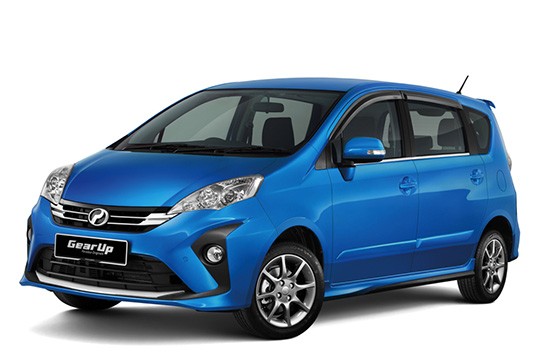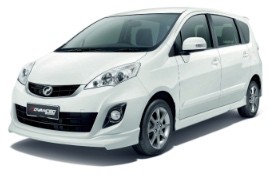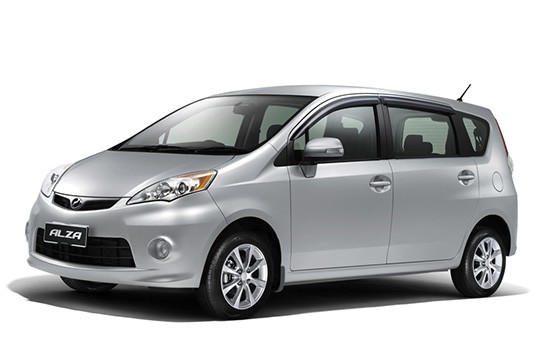PERODUA Alza Models/Series Timeline, Specifications & Photos
First production year: 2009
Engines: Gasoline
Body style: Van
In September 2018, Perodua introduced the second facelift for the Alza, the first one being launched in 2014, and brought more features for the entire range.
Perodua tried to keep its promise to provide the most affordable seven-seat minivan on the Malaysian market. Its Alza MPV was chased by the other local competitor, Proton Exora. When the Alza's second facelift arrived, it was available in three trim levels, and the Standard version sported the 2014 model-year bumpers but still kept a few other amenities from the 2019 model.
On the exterior, the 2018 Alza featured a new aerodynamic package and new headlights, but only for the SE and Advance trim levels. The Standard model kept the older ones which were similarly shaped but with a different interior lamp design. The new bumper received a slightly more aggressive styling on the side scoop area, while the grille sported two chromed horizontal slats. All versions received standard fog lights. In the back, the taillights got clear lenses instead of the red ones from the 2014 model (only for SE and Advance).
Perodua introduced more interior changes, especially for the Advance trim level, which received leather seats with a nice carbon-fiber look detail for a center strip. On the center stack, the carmaker installed a new infotainment unit for the entire range. The Advance version featured an additional screen mounted on the ceiling for the rear passengers/children for the full-options version. All versions received USB and Bluetooth connectivity, but only the Advance was available with Android Auto and touch-screen.
Under the hood, the 2018 Alza featured the same powertrain option as before. The Standard and the SE versions were fitted as standard with a five-speed manual and an option for a four-speed automatic, while the Advance version featured a standard four-speed automatic.
At the beginning of 2014, the Malaysian brand Perodua introduced the facelifted version of its small-sized MPV Perodua. This car came not only with several improvements but also with a smaller price.
Maybe Perodua was not that much known in the European or the American markets. Still, it was the biggest car manufacturer from Malaysia, ahead of the better-known Proton. Since its products were focused more on the local and neighboring countries, it was less known outside its area.
The Alza was introduced on the market in 2009, and it was related mostly to the Daihatsu Boon. In 2014, the carmaker introduced the first facelift for this MPV. At the front, the bumper was redesigned and enhanced with a pair of side scoops that hosted the fog lamps. In addition, the lower grille looked like the car was smiling. Above the bumper, the main grille was slim and surrounded on its lower side by a chromed trim, while the headlights lost the amber lenses for the blinkers. From its profile, the Alza resembled a station wagon with a taller greenhouse. Finally, at the back, the rear windscreen featured a black trim surrounding it. At the same time, the bumper was reshaped and hosted two vertical slats on its outer sides.
Inside, the Alza still offered room for up to seven people. At the front, there was a pair of seats, while the middle and the third row were split, folding in a 60/40 or 50/50 way, respectively. At the front, the driver fronted only the steering wheel since the instrument cluster was installed on top of the dashboard in the middle of it. The Alza was fitted with a touchscreen infotainment system on the center stack depending on the trim level.
There were only two drivetrains available for the 2014 Alza: a 1.5-liter mated to a five-speed manual or the same powerplant paired with a four-speed automatic.
The need for more small-sized MPVs on the Malaysian market determined the local carmakers to come with new ideas, and Perodua came with the Alza.
Perodua didn't have enough experience to develop a car from scratch and asked Toyota for help. The two brands worked on all Malaysian carmaker products, starting with Perodua's first vehicle in 1994, the Kancil, which was a rebadged Daihatsu Mira (L500).
The car was not designed or engineered by Perodua; it was developed by Daihatsu. At the front, the raked front fascia started from the bumper and continued as a slightly arched ascending line toward the car's roof. From its sides, the car resembled the Nissan Note and other small-segment minivans, but the rear windows were typical for Toyota/Daihatsu products. In the back, the carmaker installed the vertical taillights high on the D-pillars to protect them from bumps and parking-lot hits.
Inside, the Alza featured room for up to seven passengers with a 50/50 split-folding middle row and a folding third row. Access to the rear row was more difficult since the second row didn't tumble; it just folds and not even completely flat. At the front, the driver enjoyed a high seating position. Perodua kept the same dashboard as its Daihatsu Boon sibling, with a center-mounted instrument cluster.
Perodua installed the same 1.5-liter gasoline engine as its Japanese siblings and paired it with a five-speed manual gearbox. A four-speed automatic was on the options list.


